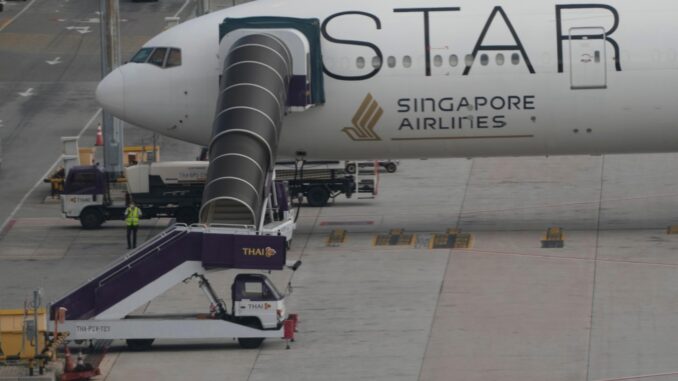
KUALA LUMPUR, Malaysia — Rapid changes in the gravitational force led to a 178-feet (54-meter) altitude drop of a Singapore Airlines flight that left one passenger dead and many others who were not buckled up injured in extreme turbulence last week, a preliminary investigation by Singapore’s Transport Ministry said Wednesday.
A 73-year-old British man died of a suspected heart attack and dozens were injured after the Boeing 777, which was flying from London’s Heathrow airport to Singapore on May 21, ran into turbulence that hurled people and items around the cabin. The plane, with 211 passengers and 18 crew members, made an emergency landing in Bangkok.
Singapore’s Transport Ministry said investigators, including those from the U.S. National Transportation Safety Board, Federal Aviation Administration and Boeing, had compiled a chronology of events based on the preliminary analysis of the flight’s data and cockpit voice recorders.
Early findings showed the aircraft was passing over the south of Myanmar at 37,000 feet (11,277 meters) feet when it began to experience vibration due to changes in the gravitational force, the ministry said. The plane then climbed to an altitude of up to 37,362 feet (11,387 meters) and increased speed possibly due to an updraft, it said. The plane’s autopilot then sought to pitch the jet downwards to its earlier altitude.
“The aircraft experienced a rapid change in G (gravitational force) … this likely resulted in the occupants who were not belted up to become airborne” before falling back down later, the ministry said. “The rapid changes in G over the 4.6 second duration resulted in an altitude drop of 178 feet … this sequence of events likely caused the injuries to the crew and passengers.”
During the turbulence, it said a pilot was heard calling out saying the fasten seat belt sign had been switched on. It said recorded data indicated the pilots manually controlled the plane for 21 seconds to stabilize it before reengaging the autopilot.
The plane made a normal, controlled descent and didn’t encounter further turbulence until it landed in Bangkok almost an hour later, the ministry said, adding that investigations are ongoing.
Passengers have described the “sheer terror” of the aircraft shuddering, loose items flying and injured people lying paralyzed on the floor of the plane.
Twenty-six people remained hospitalized in Bangkok on Wednesday. Hospital authorities earlier said injuries included spinal or spinal cord damage, skull or brain injuries and damage to bones or internal organs.
It was unclear what caused the turbulence. Most people associate turbulence with heavy storms, but the most dangerous type is so-called clear air turbulence. Wind shear can occur in wispy cirrus clouds or even in clear air near thunderstorms, as differences in temperature and pressure create powerful currents of fast-moving air.
According to a 2021 report by the U.S. National Transportation Safety Board, turbulence accounted for 37.6% of all accidents on larger commercial airlines between 2009 and 2018. The Federal Aviation Administration has said there were 146 serious injuries from turbulence from 2009 to 2021.


Be the first to comment